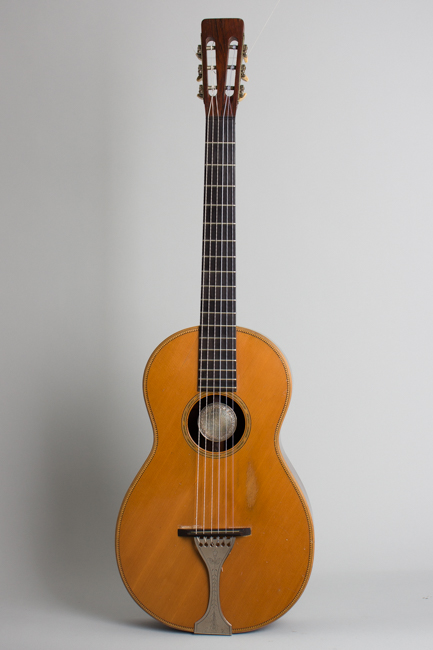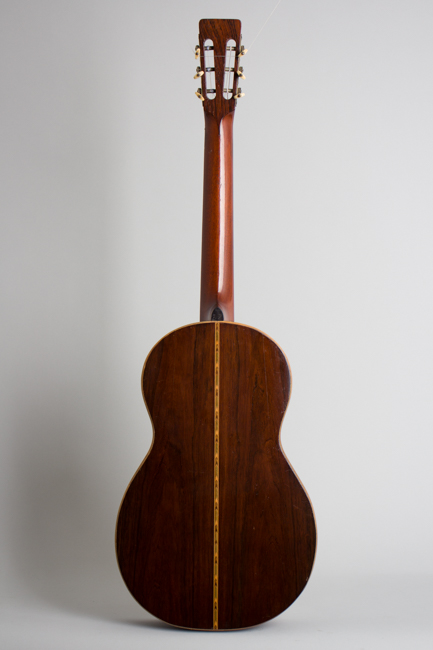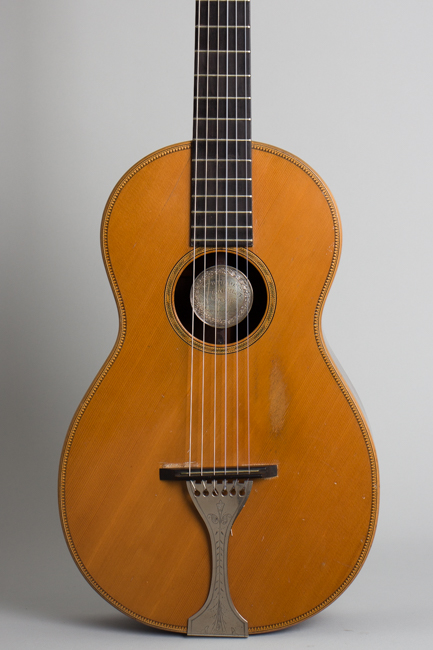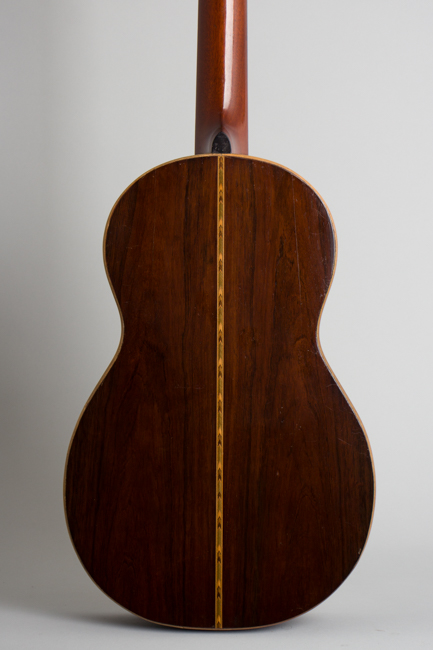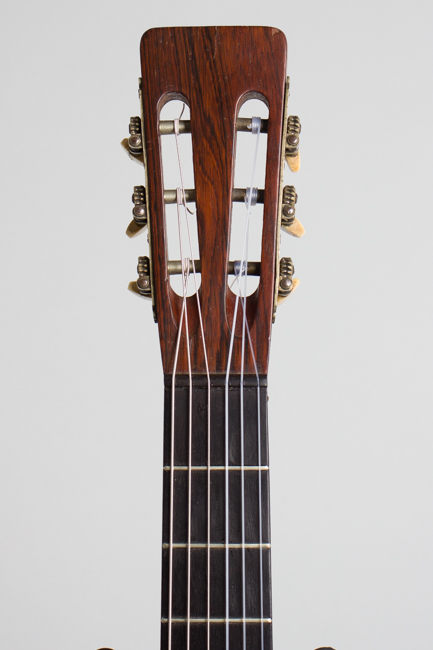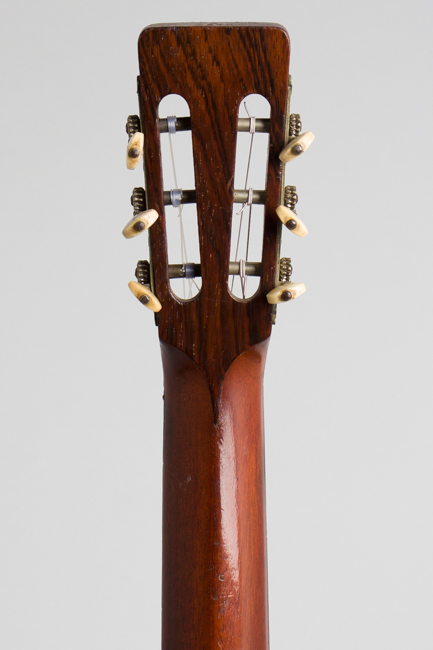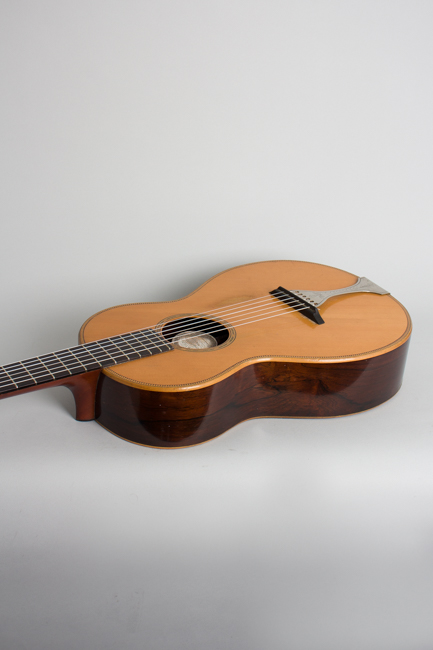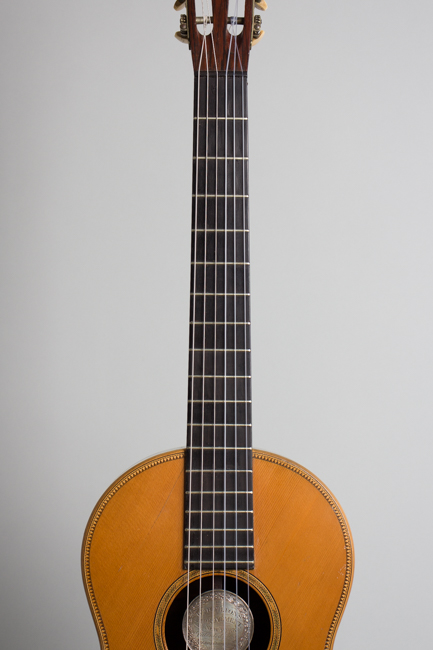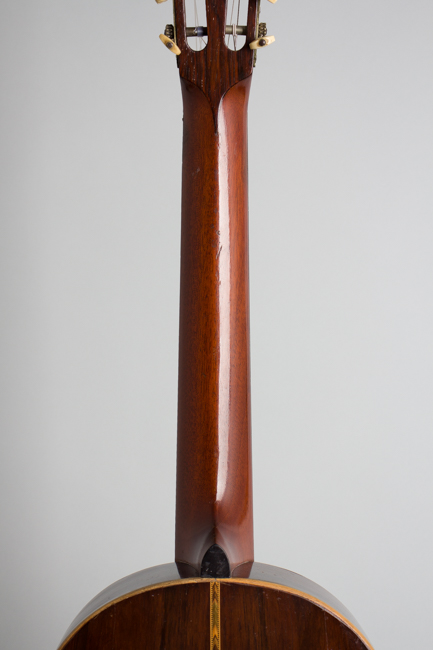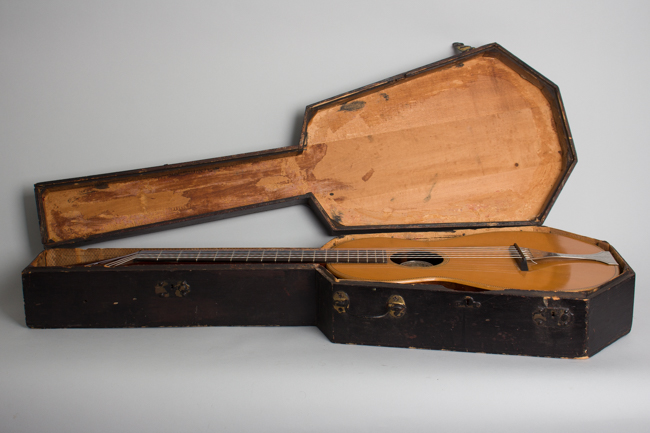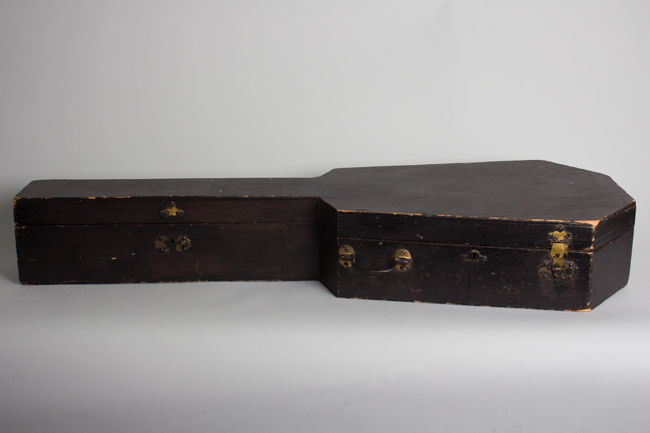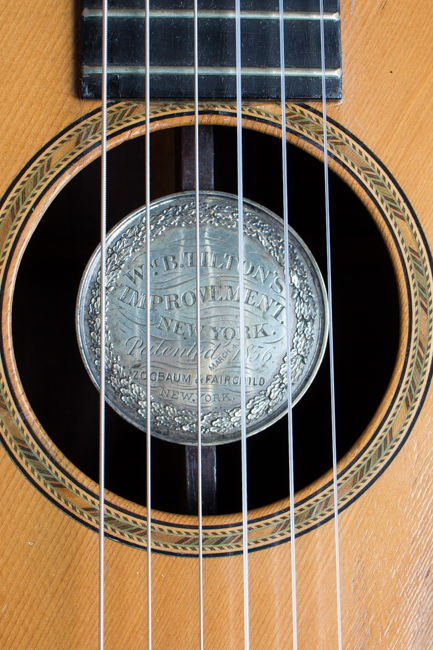Wm. B. Tilton Style 3 Parlor Guitar (1860s)
This item has been sold.
Item # 11287
Prices subject to change without notice.
Wm. B. Tilton Style 3 Model Parlor Guitar (1860s), made in New York, NY, serial # 2572, natural varnish finish, Brazilian rosewood back and sides, spruce top; mahogany neck with ebony fingerboard, original black coffin case.
This is a really splendid example of a fascinating 19th century guitar from one of the era's more celebrated designers, William B. Tilton. Tilton was certainly an original thinker; starting in the 1850s his patented "Improvements" to the guitar were refined over the next decade or so. This basically comprised a wooden center bar running down the inside of the guitar like the dowel of a banjo, intended to relieve the main stresses of string tension on the top. The other novel element is a conspicuous metal tailpiece feeding a string-through wooden bridge with a fretwire saddle in place of a typical 19th century pin bridge.
An elaborately engraved "Tilton's Improvement" disc is mounted to the internal dowel, filling much of the soundhole. This bears the patent date of March 4th, 1856 and the distributor's mark of "Zogbaum and Fairchild, New York". Ferdinand Zogbaum and Rufus Fairchild were New York dealers who bought the rights to Tilton's patents around 1860; between then and c.1868 these guitars were exclusively manufactured for them. The nickel-plated tailpiece is the earlier version with knotted strings set into round holes before proceeding through the bridge and over the fretwire saddle. The tailpiece also bears no other makers marks but is nicely engraved in a floral pattern
This is a Zogbaum and Fairchild Tilton Style #3, noted on the headstock along with a serial number. The back and sides are beautifully grained Brazilian rosewood, with wood binding and a colorful wood marquetry backstrip. The spruce top is built with an unusual diagonal grain characteristic of early Tilton instruments; presumably this was thought to make the top stronger but the idea was abandoned by the later 19th century. It is bound in white wood and bordered with "sawtooth" marquetry. The soundhole ring is decorated with a colored wood half-herringbone marquetry ring. The neck is mahogany with a dark rosewood fingerboard and ebony nut. The slotted headstock is fitted with engraved plate tuners with bone buttons.
This style was listed at $45 around 1870 by Haynes in Boston, who also purchased the rights to Tilton's patent. Tilton-style guitars were built up through he late 19th Century, although many later ones lack the quality, beauty and detail of this earlier example. Whether or not Tilton's "improvements" actually resulted in a better sounding guitar, this remains a lovely playable instrument, absolutely distinctive and very well-crafted with a sweet sound.
This guitar is an amazing piece of New York area history. It is sturdily built for its age and can be well-recommended as a gigable 19th century piece especially for use in situations such as Civil War re-enacting, authentic Western or minstrel re-creations where an accurate and fully functional 1860s guitar is desired. It plays very well with NylGut strings and includes the original 1860s "coffin" case.
Overall length is 37 1/4 in. (94.6 cm.), 12 1/8 in. (30.8 cm.) wide at lower bout, and 3 7/8 in. (9.8 cm.) in depth at side, taken at the end block. Scale length is 24 5/8 in. (625 mm.). Width of nut is 1 15/16 in. (49 mm.).
This guitar is in amazingly well preserved all-original condition for a mid-19th century instrument, fully playable which is not often the case with guitars of 150+ year old vintage. There has been some repair work, but again less than many. The thin varnish finish is all original which once more is rare to find 150+ years on. There are numerous small dings, dents and scrapes overall but only one spot of heavier finger wear through the finish below the strings.
There is a repaired grain split to the top along a diagonal line above the fingerboard, but other than that the top is completely solid with no other cracks or distortion. The area of the back off the front edge has a couple of sealed grain splits, solidly but visibly repaired with no touch up added. The neck has been reset and the original bridge was once cut down from below and is now neatly restored to its original height. We would assume the guitar was refretted at some point (the fingerboard shows some minor work) but they are quite old, and might be authentic period wire. The beautiful original engraved-plate tuners are functional with some cracking to the bone buttons; a small piece is missing from the B string knob.
The guitar is currently strung with NylGut strings for a more period-correct sonic experience, but in our experience Tilton's design makes his instruments adaptable to silk & steel stringing if desired, which is NOT true of nearly all other 19th century guitars. This is a really amazing survivor, on the planet since the industrial revolution was new and not TOO much the worse for wear. It lives in the original coffin case, missing most of the lining and with no survival latches but suitable for storage at least. Excellent - Condition.
This is a really splendid example of a fascinating 19th century guitar from one of the era's more celebrated designers, William B. Tilton. Tilton was certainly an original thinker; starting in the 1850s his patented "Improvements" to the guitar were refined over the next decade or so. This basically comprised a wooden center bar running down the inside of the guitar like the dowel of a banjo, intended to relieve the main stresses of string tension on the top. The other novel element is a conspicuous metal tailpiece feeding a string-through wooden bridge with a fretwire saddle in place of a typical 19th century pin bridge.
An elaborately engraved "Tilton's Improvement" disc is mounted to the internal dowel, filling much of the soundhole. This bears the patent date of March 4th, 1856 and the distributor's mark of "Zogbaum and Fairchild, New York". Ferdinand Zogbaum and Rufus Fairchild were New York dealers who bought the rights to Tilton's patents around 1860; between then and c.1868 these guitars were exclusively manufactured for them. The nickel-plated tailpiece is the earlier version with knotted strings set into round holes before proceeding through the bridge and over the fretwire saddle. The tailpiece also bears no other makers marks but is nicely engraved in a floral pattern
This is a Zogbaum and Fairchild Tilton Style #3, noted on the headstock along with a serial number. The back and sides are beautifully grained Brazilian rosewood, with wood binding and a colorful wood marquetry backstrip. The spruce top is built with an unusual diagonal grain characteristic of early Tilton instruments; presumably this was thought to make the top stronger but the idea was abandoned by the later 19th century. It is bound in white wood and bordered with "sawtooth" marquetry. The soundhole ring is decorated with a colored wood half-herringbone marquetry ring. The neck is mahogany with a dark rosewood fingerboard and ebony nut. The slotted headstock is fitted with engraved plate tuners with bone buttons.
This style was listed at $45 around 1870 by Haynes in Boston, who also purchased the rights to Tilton's patent. Tilton-style guitars were built up through he late 19th Century, although many later ones lack the quality, beauty and detail of this earlier example. Whether or not Tilton's "improvements" actually resulted in a better sounding guitar, this remains a lovely playable instrument, absolutely distinctive and very well-crafted with a sweet sound.
This guitar is an amazing piece of New York area history. It is sturdily built for its age and can be well-recommended as a gigable 19th century piece especially for use in situations such as Civil War re-enacting, authentic Western or minstrel re-creations where an accurate and fully functional 1860s guitar is desired. It plays very well with NylGut strings and includes the original 1860s "coffin" case.
Overall length is 37 1/4 in. (94.6 cm.), 12 1/8 in. (30.8 cm.) wide at lower bout, and 3 7/8 in. (9.8 cm.) in depth at side, taken at the end block. Scale length is 24 5/8 in. (625 mm.). Width of nut is 1 15/16 in. (49 mm.).
This guitar is in amazingly well preserved all-original condition for a mid-19th century instrument, fully playable which is not often the case with guitars of 150+ year old vintage. There has been some repair work, but again less than many. The thin varnish finish is all original which once more is rare to find 150+ years on. There are numerous small dings, dents and scrapes overall but only one spot of heavier finger wear through the finish below the strings.
There is a repaired grain split to the top along a diagonal line above the fingerboard, but other than that the top is completely solid with no other cracks or distortion. The area of the back off the front edge has a couple of sealed grain splits, solidly but visibly repaired with no touch up added. The neck has been reset and the original bridge was once cut down from below and is now neatly restored to its original height. We would assume the guitar was refretted at some point (the fingerboard shows some minor work) but they are quite old, and might be authentic period wire. The beautiful original engraved-plate tuners are functional with some cracking to the bone buttons; a small piece is missing from the B string knob.
The guitar is currently strung with NylGut strings for a more period-correct sonic experience, but in our experience Tilton's design makes his instruments adaptable to silk & steel stringing if desired, which is NOT true of nearly all other 19th century guitars. This is a really amazing survivor, on the planet since the industrial revolution was new and not TOO much the worse for wear. It lives in the original coffin case, missing most of the lining and with no survival latches but suitable for storage at least. Excellent - Condition.
